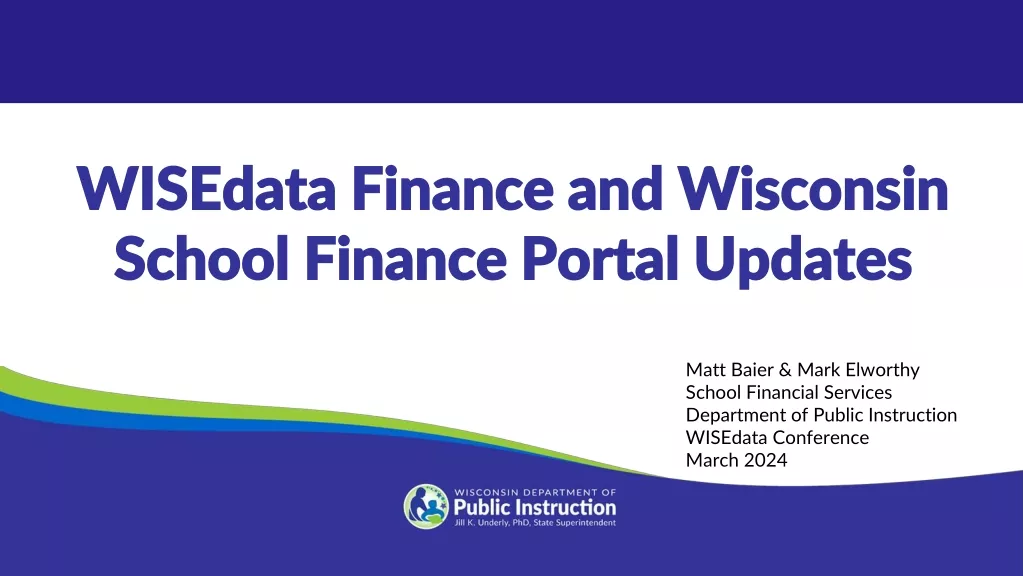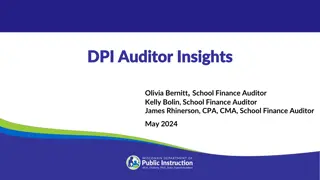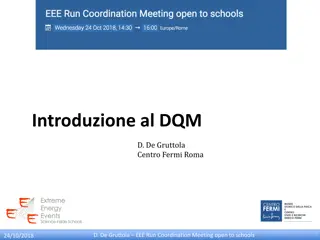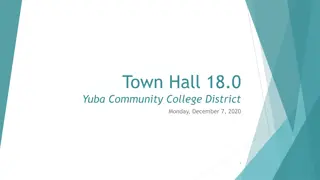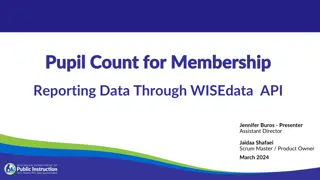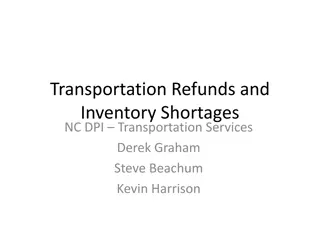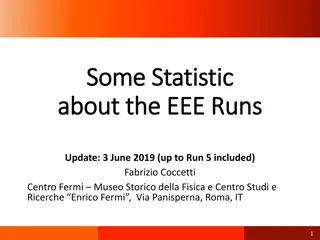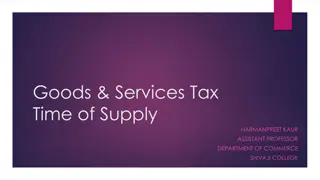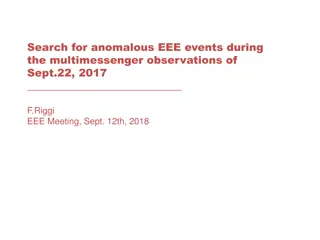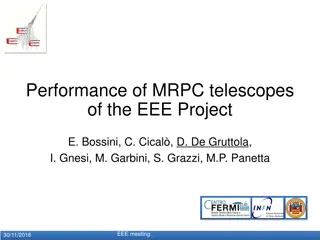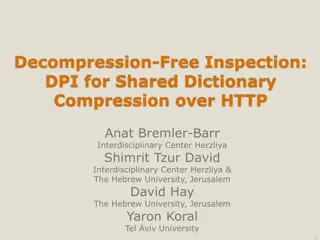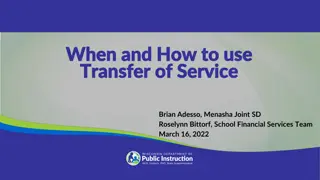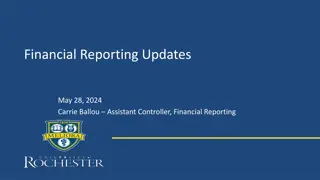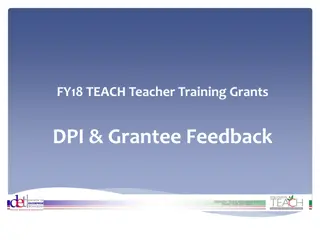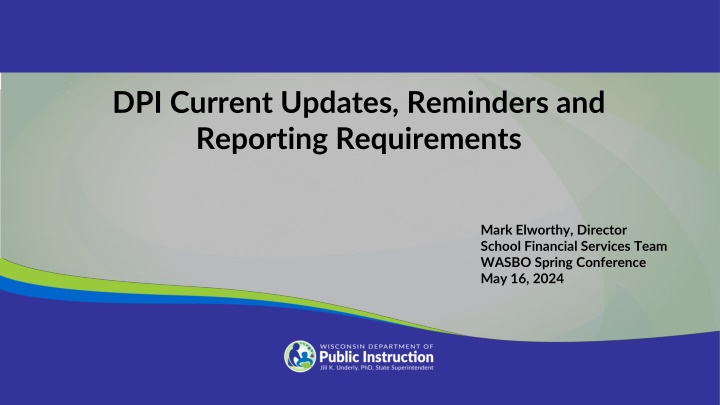
Energy Efficiency Exemptions Overview for School Financial Services Team Conference
Explore the Energy Efficiency Exemptions overview presented by Mark Elworthy at the WASBO Spring Conference. Learn about revenue limit exemptions and resolutions related to energy efficiency projects in school districts.
Download Presentation

Please find below an Image/Link to download the presentation.
The content on the website is provided AS IS for your information and personal use only. It may not be sold, licensed, or shared on other websites without obtaining consent from the author. If you encounter any issues during the download, it is possible that the publisher has removed the file from their server.
You are allowed to download the files provided on this website for personal or commercial use, subject to the condition that they are used lawfully. All files are the property of their respective owners.
The content on the website is provided AS IS for your information and personal use only. It may not be sold, licensed, or shared on other websites without obtaining consent from the author.
E N D
Presentation Transcript
DPI Current Updates, Reminders and Reporting Requirements Mark Elworthy, Director School Financial Services Team WASBO Spring Conference May 16, 2024
Agenda 1. Energy efficiency exemption to revenue limits 2.Summer school FTE & fee reconciliation 3.Fund 80 eligible costs 4. Transfer of service (TOS) exemption to revenue limits 5. WISEdata Finance and WiSFiP
Energy Efficiency Exemptions - Overview Energy Efficiency Exemption Resolution Overview A school board was able to adopt a resolution to increase the revenue limit otherwise applicable to a school district under s. 121.91 (2m), Wis. Stats. in any school year by an amount spent by the school district in that school year on a project to implement energy efficiency measures or to purchase energy efficiency products. District may use this non-recurring exemption to the revenue limit to pay for an energy efficiency project in a single year or to repay a note, bond or loan used to finance the project.
Energy Efficiency Exemptions - Overview Energy Efficiency Exemption (EEE) to the Revenue Limit Per 2017 Wisconsin Act 59 (2017-19 Budget), school boards are prohibited from adopting a resolution to utilize the Energy Efficiency Exemption to the revenue limit after December 31, 2017 (through December 3018). A School Board may issue debt after December 31, 2017, to fund the energy efficiency exemption project(s) that were approved by the School Board prior to December 31, 2017. Under current law, resolutions may not be passed after December 31, 2017. This includes changes to any existing resolutions.
Energy Efficiency Exemptions - Overview 2017 Wisconsin Act 59 Moratorium Districts are no longer able to enter energy efficiency data into the School Finance Portal for the portal has been closed per 2017 Wisconsin Act 59 (2017-19 Budget). Districts may review their utility savings by going to the SAFR Reporting Portal. However, districts that need to update their energy efficiency utility savings or have other related questions should contact dpifin@dpi.wi.gov
Energy Efficiency Exemption is an Allowable Exemption Revenue Limits Non-Recurring - Line 10 C The EEE is on line 10C of the revenue limit worksheet. A non-recurring exemption to fund a project to implement energy efficiency measures or to purchase energy efficiency products. See DPI Rule and information at: Exemptions Districts will need to review their Utility Savings to determine if they are up to date in the District s Financial Data Home EEE page in DPI SAFR Districts must complete the multi-year reconciliation located on page 4 of the worksheet when completing revenue limit worksheet.
Energy Efficiency Exemption is an Allowable Exemption Revenue Limits Non-Recurring - Line 10 C
Step 3: Determine Allowable Exemptions Line 10C Energy Efficiency
Summer Membership Reporting Summer Membership Reporting PI-1804 or the PI-1804-1805 Excel Workbook Milwaukee and the suburban districts use a special workbook (W1804-1805) that counts ITP students (Chapter 220) Report Totals Using On-line PI-1804 Reporting Portal in the Non-Financial Data within DPI SAFR
Summer Membership Reporting Summer Membership Reporting- -PI PI- -1804 1804 Summer and Interim Sessions start and end during periods outside of the school year. The first day of summer school is typically the start of the next school year formembership purposes only, not the fiscal year. The Excel worksheet (PI-1804/PI-1804-1805) is available to calculate minutes used for calculating a school district s Summer FTE.
Summer School Reporting Summer School Reporting The data on the 1804 W2 Summary Sheet of the Excel worksheet is reported to DPI through the PI-1804 on-line portal at the conclusion of summer school and is due September 27, 2024. The summer school report is one of the few reports that asks you to calculate the FTE count as opposed to a head count. Keep the Excel spreadsheet, as your auditor will review the information used to calculate your summer membership FTE and fee reconciliation.
Summer School Reporting Summer School Reporting
Summer School Reporting Summer School Reporting
Summer Summer and Interim Session and Interim Session Fees Fees DPI SFS Team's School Fees Legislative changes such as revenue limits, changes in the equalized aid formula and general tightening of school funding have led some school districts to explore the use of "user fees" to supplement their budgets. Proponents argue that such fees can result in lower local taxes and increased services for students. Opponents argue that fees place a burden on poor and middle income families, thereby denying them equal educational opportunities. Click the appropriate links below for more information. Overview Statute-authorized Fees Statute-prohibited Fees User Fee Categories Frequently Asked Questions
Summer Summer and Interim Session and Interim Session Fees Fees The fee must fund an item that is legally permitted and actually purchased for summer school use The fee may not be used to subsidize the cost of any other classes, students or administration The fee must be based upon the actual cost of the applicable item(s) the student received If your district is required to have a membership audit, the auditor will also review your summer school FTE and any associated summer school fees
Summer Summer and Interim Session and Interim Session Fees Fees Fees for the resident student or parent may be charged for individual use supplies (towels, gym clothes, band instruments, notebooks, pencils), textbooks, or similar items (workbooks) if the district claims the members for State General Aid under ss. 121.14. Fees may be charged for social, recreational, or extracurricular summer classes and programs which are neither credited toward graduation nor eligible for State General Aid [s. 118.04(4)]. DPI SFS Team's School Fees
Fund 80 - Community Programs and Services
Fund 80 The authority for a school board to operate Community Programs and Services (Fund 80) is established under sec. 120.13(19), Wis. Stats., and PI 80. 120.13(19) concludes with this sentence: The school board may not expend moneys on ineligible costs, as defined by DPI by rule. Costs associated with such programs and services shall not be included in the school district's shared cost under s. 121.07 (6). Fund 80 Community Services Overview
Fund 80 A bit of history of Fund 80 The levy for Fund 80 was removed from revenue limit control starting in the 2000-01 school year [s. 121.91(2m)(e)1.] Fund 80 community programs and services are mostly completely funded by local taxpayers. Fund 80 costs have never been a factor in the equalization aid calculation. Chapter PI 80 Community Programs and Services was created per 2013 Wisconsin Act 306. Effective Date: May 1, 2015. Fund 80 Community Services Overview
Fund 80 In addition, PI 80.02 defines ineligible Fund 80 costs as: 1. Costs for any program or service that is limited to only school district pupils. 2. Costs for any program or service whose schedule presents a significant barrier for age-appropriate school district residents to participate in the program or service. 3. Costs that are not the actual, additional cost to operate community programs and services under s. 120.13 (19), Stats. (No percentages of cost allowed). 4. Costs that would be incurred by the school district if the community programs and services were not provided by the school district
Does a program or service belong in Fund 10 (General) or Fund 80? Does a program or service belong in Fund 10 (General) or Fund 80? It is the Board of Education and the District Administration who decide what meets the criteria to be in Fund 80. It is a local decision. Districts are encouraged to use the Decision Tree for potential Fund 80 Community Programs and Services Fund 80 Community Services Decision Tree before proceeding with a change. Through this evaluation process the Board and Administration will decide if certain activities are associated with: a. The educational curriculum (curricular and extra-curricular activities) including summer school programs where student minutes will be counted (Fund 10); or b. If the program has the primary function of serving the community. (Fund 80).
Fund 80 2013 Act 306 requires that Fund 80 expenditures be audited by the school district s auditor. State law has consistently excluded from Shared Costs (for General Aid purposes) any Fund 80 expenditures. If a Fund 80 expenditure audit determines that a district had inappropriately coded Fund 80 expenditures to Fund 10, those expenditures would have to be removed from Fund 10 and would decrease the district s Shared Costs for General Aid purposes. Wis. Stat. 121.91(4)(r) Districts using Fund 80 will need to address this question: When the program/activity is held in a K-12 facility, which Fund is paying for the utilities and other related cost?
Fund 80 Current law requires DPI to determine if ineligible Fund 80 expenditures exist If reported in the audit process; DPI must reduce the district s allowable revenue limit authority the following year by the amount of the ineligible Fund 80 expenditures; structured as a negative exemption rather than a reduction to the district s base. This was first applied to the Revenue Limit calculation for the 2015-16 school year, based on 2014-15 expenditures.
Fund 80 Preparing for an CPS audit; Each program or service will need to be documented within the district s accounting system. Supporting documentation will be part of the audit process. Community Service Fund Information Wisconsin Uniform Financial Accounting Requirements (WUFAR) will assist each district in this process. OurFund 80 Community Services Overview webpage provides the most recent information regarding Fund 80. Latest News includes information on how Fund 80 could re-pay Fund 10 for operational costs.
What is Transfer of Service (TOS) What is Transfer of Service (TOS) The Transfer of Service Exemption Wis. Stat. The Transfer of Service Exemption Wis. Stat. 121.91(4)(a)2 121.91(4)(a)3 121.91(4)(a)3 provides that a school district which provides that a school district which assumes responsibility providing a program or service providing a program or service from another governmental unit from another governmental unit may request and may be granted and may be granted an exemption to the district revenue limit an exemption to the district revenue limit per state statute. statute. 121.91(4)(a)2 and assumes responsibility for and Wis. Stat. Wis. Stat. for may request per state 2
What is Transfer of Service (TOS) What is Transfer of Service (TOS) A TOS request can be for an individual student with a disability or for a limited- English proficient student. The Transfer of Service (TOS) request for an individual student is for the estimated additional, increased cost as determined after a review of the district s current staffing and service capacity of that program or service less the estimated amount of aid the district will receive for the child or pupil in the following school year. Individual student requests are processed through the PI-5000 TOS online portal. Majority of requests are for individual students. 3
What is Transfer of Service (TOS) What is Transfer of Service (TOS) A TOS request can also be for the increased cost for providing a service transferred between the school district and a local municipality, such as city or county. Transfers of providing the service and financial responsibility between a school district and a local municipality where the municipality previously provided the service and paid related costs are processed through a Narrative Transfer of Service application. Does the district have sole responsibility for determining and directing the service? 4
Transfer of Service (TOS) Request for a Student Review six steps to determine eligibility. If eligible, enter request in the online application system. 5
TOS Eligibility TOS Eligibility Eligibility Requirement #1: The student came to your district from another governmental unit that had responsibility for their education. Wisconsin school districts, including: A district that educates a student as a result of their residing in a juvenile detention facility, county jail, group or foster home, or another county- ordered placement without an educational program (whether or not that district received State Tuition reimbursement for the student) A district that places a student with one of the DPI schools (WCVBI or WESP- DHH) A district charter school 6
TOS Eligibility TOS Eligibility Eligibility Requirement #1: The student came to your district from another governmental unit that had responsibility for their education. Other Wisconsin governmental units : Independent (2r or 2x) charter schools Wisconsin counties with birth-to-three programs for children with disabilities Facilities run by the State of Wisconsin which are considered LEAs: Lincoln Hills School, and the Winnebago and Mendota Mental Health Institutes 7
TOS Eligibility TOS Eligibility Eligibility Requirement #1: The student came to your district from another governmental unit that had responsibility for their education. Public schools outside Wisconsin, including : Schools operated by another state or sub-unit of another state, Schools operated by the federal government; and Schools operated by a foreign country or sub-unit of a foreign country 8
TOS Eligibility TOS Eligibility Eligibility Requirement #2: The student is a student with a disability or limited English proficiency Transferred into the district with an identified need Typically, the need will be identified by an Individualized Education Program (IEP) or English Learner (EL) service plan with a Limited English Proficient (LEP) classification of 1 through 5. A district is not eligible to receive a Transfer of Service exemption for new services required by an evaluation or re-evaluation of a student after they transfer into the district. 9
TOS Eligibility TOS Eligibility Eligibility Requirement #3-4: Be within the current application timeline 2023-24 (Fiscal Year 24) 2024-25 (Fiscal Year 25) 2025-26 (Fiscal Year 26) Jun 23 Jul 23 Aug 23 Sept 23 Oct 23 Nov 23 Dec 23 Jan 24 Feb 24 Mar 24 Apr 24 May 24 Jun 24 Jul 24 Aug 24 Sept 24 Oct 24 Nov 24 Dec 24 Jan 25 Feb 25 Mar 25 Apr 25 May 25 Jun 25 Jul 25 Aug 25 Sept 25 Students eligible for FY25 TOS app TOS app open for FY25 Students eligible for FY26 TOS app TOS app open for FY26 10
TOS Eligibility TOS Eligibility Eligibility Requirement #5: The district has not already received a TOS exemption for the student Students enrolled between June 2023 September 2024 are eligible for the application in the fall of 2024 Students enrolled between June 2024 September 2025 are eligible for the application in the fall of 2025 The timeline crosses two school years the district can only submit one exemption request per student Did the student start after the fall of 2024 application period? Did the student have an evaluation that added services? 11
TOS Eligibility TOS Eligibility Eligibility Requirement #6: There is an increased cost for a service the district provides An increased cost is defined as a new and additional district service compared to the prior year. Increased taxes, fees or compensation do not qualify as an increased cost. This is an increased cost due to additional services provided. It is not the same as just an increase in cost. District can demonstrate an increase in cost over prior year and current transfer of service exemptions are being fully utilized. 12
TOS Eligibility TOS Eligibility Eligibility Requirement #6: There is an increased cost for a service the district now provides TOS Eligible Example: The district never had a speech and language teacher before, now they have a new student who needs that service so they must hire a speech and language teacher. Not TOS Eligible Example: The district has a new student who needs speech and language services and will now participate in their existing speech and language program. 13
Using the Decision Tree Using the Decision Tree Please use our Transfer of Service Decision Tree, located on our website at https://dpi.wi.gov/sfs/limits/exemption s/transfer-service to assist you with the TOS process 1 4
Using the Decision Tree Using the Decision Tree Your district registrar or other designated person should document students who move into your district each school year, where the students come from (another governmental unit), and if they arrived with: an identified disability or proficiency program. participating in a limited English 1 5
Using the Decision Tree Using the Decision Tree In late April, the district should review the list of students identified and determine the following for each student: Did the student s arrival cause the district to incur a cost that was not budgeted prior to their arrival? Does the district believe this student will return in the fall? 1 6
Using the Decision Tree Using the Decision Tree Determine what additional resources the district will need in the coming year (not including the current year cost) to meet the identified needs the student arrived with. Review available resources Will resources be made available because other students have graduated or relocated? Was a previous TOS request approved? 1 7
Sample District Process Sample District Process Create a shared spreadsheet Keep separate tabs for ELL and Special Education Students FY25 Timeline: June 2023 September 2024 Track expenses for the school year and the summer or LEP need Track new students coming into the district from other governmental units with an IEP to evaluate possible TOS requests Hold a meeting in late May/early June with key staff who work with IEP or LEP students 1 8
Sample District Process Sample District Process In late June/early July enter each TOS request that can be justified. Monitor enrollment of students that leave the district over the year and during the summer. Reevaluate staffing ratios/double check staffing levels Utilize the decision tree to determine eligibility 1 9
TOS Request Getting Access to the PI-5000 Management (AUM) system. TOS online application security is processed through the Application User (OPAL) and Homeschool Reporting (HOMER) applications. District administrators already have access to AUM for Open Enrollment Transfer of Service-LEP and/or Transfer of Service-SPED applications. Only your district administrator can authorize district staff to have access to 2 0
Making a TOS Request Making a TOS Request Completing Part A Questions similar to the Decision Tree: Where did the student come from? Enrollment date disability or limited English proficiency Confirm the student came to you with a cannot meet the student s needs and provide financial information to support that Verify the district s current resources Due date mid-September 2 1
Making a TOS Request Making a TOS Request Completing Part B If the student transferred from a WI school district, the other school district now confirms the information from Part A: Confirms the student was a resident in that district Confirms withdrawal date Withdrawal date to enrollment in your district must be within 45 days Confirms the student has a disability or limited English proficiency Verifies there were costs involved to meet the student s needs Due date mid-September 2 2
Making a TOS Request Making a TOS Request Completing Part C Part A Review your information entered from Costs column You will need to enter values in the New the New Costs will be the amount being requested by the school district The values entered by the district under Part C, provide a narrative in the text box at the bottom of the screen to further explain reason for the change If totals have changed between Part A and Due date late-September 2 3


